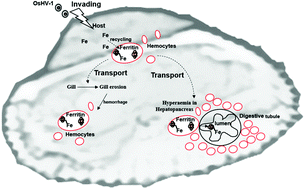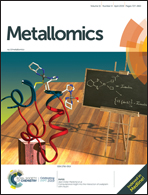OsHV-1 infection leads to mollusc tissue lesion and iron redistribution, revealing a strategy of iron limitation against pathogen†
Abstract
The mass mortality of molluscs caused by OsHV-1 infection has frequently occurred worldwide in recent years. Meanwhile the interaction between OsHV-1 and its host is largely unknown. Innate immunity mainly makes up the mollusc defense system, due to the lack of adaptive immunity in invertebrates. The iron limitation strategy is an indispensable facet of innate immunity across vertebrate and invertebrate species. In this study, an iron limitation strategy was interestingly found to contribute to mollusc innate immune responses against OsHV-1 infection. Firstly, ark clams, Scapharca broughtonii, were experimentally infected with OsHV-1, and serious hyperaemia in hepatopancreases and the erosion of gills were observed post OsHV-1 infection according to a histology assay. Meanwhile, based on quantification and Prussian blue staining, the process of iron efflux from ark clams was described post OsHV-1 infection. Secondly, ferritin, as an important iron storage protein, was characterized in ark clams and showed significant iron binding activity. According to the results of an immunohistochemistry assay, ferritin was supposed to be responsible for the iron translocation in ark clams post OsHV-1 infection. Its expression level was significantly fluctuant in response to OsHV-1 infection. Finally, oxidative stress was assessed by the analyses of H2O2 content, total antioxidant capacity and MDA level post OsHV-1 infection. Supplementary iron was found to promote ROS generation and death of hemocytes in vivo. These results highlighted that microenvironment changes in the essential nutrient iron should be an important aspect of the pathogenesis of OsHV-1 disease.



 Please wait while we load your content...
Please wait while we load your content...